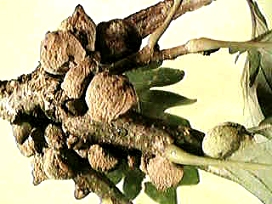 |
Nuisance
of the Week: |
|||||||||||||
|
Get Our Free Newsletter
Home
|
Generally, these gall insects do not cause significant damage to their hosts though some of the leaf galls can cause deformity to make a tree unsightly. Also, severe infestations of twig galls can cause twig dieback or, in rare cases, death. However, just because a twig is covered with galls does not mean that it is dead. Twigs that otherwise look like a solid mass of galls may still leaf out in the spring. Insecticide sprays applied when galls are noticed are ineffective since damage has already occurred. Also, the larvae are unaffected due to the protection afforded by the gall. Emerging adult wasps and flies can be killed by insecticide but long periods of emergence and short residuals of most contact insecticides make this impractical. Stem twig galls can be pruned if this is deemed to be practical and necessary. In short, this is a problem that is best ignored unless pruning is done to improve the appearance of the tree. Nuisance of the Week is brought to
you in cooperation with the Kansas
State University Research & Extension
|
|||||||||||||
|
© 1999 - 2009 Savvygardener.com, Inc. All rights reserved. If you wish to copy, transmit, or otherwise duplicate any of the material from our website please ask us first. Thank you. |
||||||||||||||
 A
number of tiny non-stinging wasps, mites and flies cause abnormal growths
to develop on the leaves,
A
number of tiny non-stinging wasps, mites and flies cause abnormal growths
to develop on the leaves,